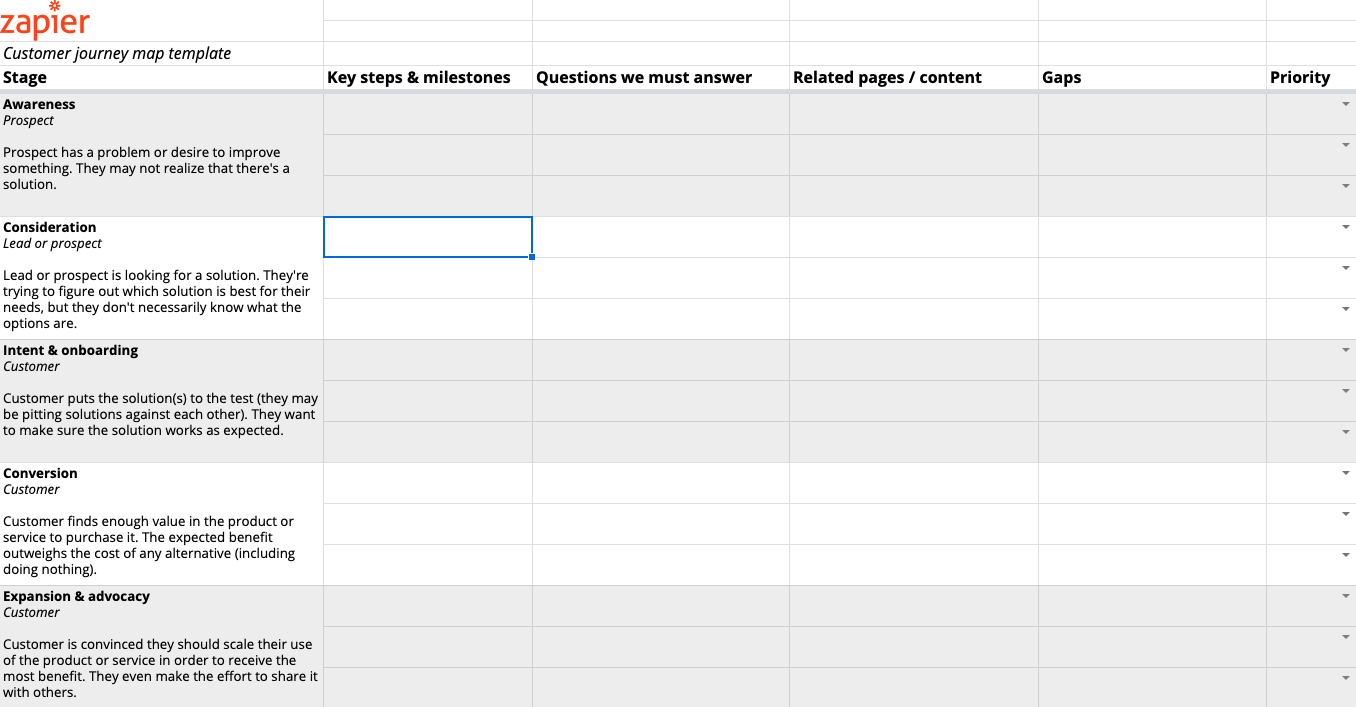Customers play all sorts of roles in business, so it’s no surprise that businesses are generally moving toward a customer-centric model. As the co-founder of Digital Dot, a digital marketing agency, I’ve seen this shift up close. And with customers becoming increasingly tech-savvy, increasingly engaged, and increasingly demanding, businesses need to adapt—and so do marketers.
Automate your marketing
Streamline your processes, minimize recurring tasks, and increase ROI.
This is where customer journey mapping enters the picture. It can help you acquire and retain customers in an always-changing landscape, so you’re always one step ahead.
Here, I’ll walk you through the process of customer journey mapping and share a customer journey map template created by the Zapier team.
What is customer journey mapping?
Customer journey mapping is about following your customers’ journey with your brand, starting from their very first impression. A customer journey map helps you visualize how your customers navigate throughout your touchpoints: promotional material, social media channels, your product itself—you name it.
As an example, think of any recent purchase you’ve made, and try to trace your journey back.
-
When and where was your first contact with the product or service?
-
How many channels of communication with the company did you have available?
-
How was the contact you had, if any? Was it personal or formulaic?
-
Were your problems, if any, solved? If so, were they solved in a timely manner?
-
What do you now know about the brand besides the product or service itself?
Of course, every customer is different. But you can’t create a customer journey map for every single one—and you don’t need to. Instead, you can segment your audience and then create customer personas. Then you only need to create a map for each persona.
Making separate maps for each persona is key. One of our clients was focused on two personas that were formed from their two main segments: stay-at-home moms and retirees. When they added a third persona, college students, they didn’t create a new map. In doing so, they neglected to consider the role social media played in college students’ early phases. This created a blind spot, and when we suggested they create another customer journey map for this third persona, it all became clear.
The benefits of customer journey mapping
Purchases are no longer a simple process of seeing a product or service and buying it: there are endless touchpoints a customer has with your product or service. And that’s why you need to create a customer journey map—to be sure you’ve accounted for all those touchpoints and how they affect your customers. Here are the main benefits you’ll get from your customer journey map:
-
Touchpoint optimization. Through a clear understanding of how each of your touchpoints performs, you can adjust them individually with more precision. Many problems don’t need holistic approaches but hyper-specific solutions.
-
Pain point insights. Speaking of problems, pain points can also be recurring and specific. Mapping your customers’ journey can help highlight specific pain points for you to address.
-
Enhanced customer experience insights. Through customer profiling and a better overview of all the touchpoints that make a journey, you can acquire more precise and actionable customer experience insights.
How to create a customer journey map
Once you have your personas, your customer journey map can take a variety of forms. It might be a basic table with a few columns, or it might be a flowchart showing each step of the process—or something in between. If you go the simple route, you’ll need to just break the journey down into phases. Here are the common stages found in a customer journey map—and the ones included in our template—but you can adjust as needed, depending on your business model.
Awareness
Customers start their journey with a problem, but they might not even know there’s a solution yet. You need to help them figure that out.
Sometimes called “discovery,” this is when your customers learn who you are. It’s all about how easy it is for a customer to hear about your business—after all, there’s little point in analyzing how customers react to your material before ensuring they get to see it. This is your brand awareness step and includes everything from paid advertising and SEO to press mentions.
First impressions can make or break a journey, so you need to think about your customers’ first reactions to your brand in this stage.
Consideration
Sometimes called “research,” this is when your customers learn more about the potential solutions to their problem, including your product or service.
Your leads have options (your competitors), and they’re considering lots of them. How you present yourself to potential customers—including highlighting your unique selling point—is a key touchpoint. If you discover that many customers fail to engage after the first contact, that’s often a sign that your presentation is lacking. Consider how you present both your product or service and your brand—customers want to know the brand they’re buying from, not just what they’re buying.
Intent & onboarding
Not every business will include this step, but it’s especially important for SaaS or any product or service with a trial period. This is when the customer puts the product or service to the test to make sure it works as expected. (And, of course, they might be trying out a number of solutions at this stage.)
Conversion
Sometimes called the “decision” stage, this is when your customers bite the bullet and make a purchase or sign up. Do you make it easy to do so? Do people abandon their carts or stop responding to emails after making an initial inquiry?
Expansion & advocacy
What happens after someone becomes a customer? You want to retain customers and be sure they buy from you again or expand their usage of your service. So don’t stop at conversion: think about everything post-sale, including onboarding new customers, offering great customer service, and even getting them to become brand advocates.
Customer journey map template
Here’s a customer journey map template to start with. The Zapier Marketing team created it, and they use a version of it for their own work. Make a copy, and then adapt it to your needs.
You’ll see that this template also includes a section for content gaps—so in addition to serving as your journey map, it can also help you identify touchpoints that are missing on your end. Below, we’ll walk through the information included in each stage.

Key steps & milestones
In this section, you’ll jot down the main things that the prospect, lead, or customer is doing during this stage. For example, if you’re a personal trainer, an awareness stage key step might include something like “Prospect wants to get in shape.” If you offer an email newsletter app, an expansion and advocacy stage key step might be “Customer upgrades their plan.”
Each step will likely have more than one key step or milestone—that’s good. You should be specific enough to be able to create touchpoints, content, and marketing campaigns geared toward each milestone.
Questions we must answer
For each key step or milestone, think about the questions that the prospect, lead, or customer would be asking. In the awareness stage, it might be things like “How can I do X better?” or “What is [your product name]?” In the consideration phase, questions like “Is this worth my time/money?” or “Will this help me solve my problem?” will come to the forefront.
Related pages / content
For each question, you want to be sure you have touchpoints to answer it. For the awareness stage, this will usually be things like blog articles or product pages; for the consideration phase, you might think about demo videos, customer stories, or a competitor comparison. And as you get down toward expansion and advocacy, you’ll start thinking about customer education materials.
This section is where you list all the touchpoints you already have.
Gaps
This is maybe the most important part of your customer journey map and something that lots of templates miss: what don’t you have that you need to have to reach customers at each stage of the journey? Get creative here, think about all your marketing channels, and don’t limit yourself to the usual suspects. Here are some ideas to get you started (and don’t be afraid to mix and match):
Awareness:
-
About page
-
Blog posts
-
eBooks
-
Infographics
-
Product landing pages
-
Ads
Consideration:
Intent & onboarding:
Purchase:
Expansion & advocacy:
-
Brand advocacy program
-
Experts program
-
Customer spotlights
Priority
The Zapier template has a dropdown for low, medium, high, and very high, but you can customize these, even changing them to quarters or months that you think the gaps need to be filled by.
It’s not one and done
Customers are always changing. That’s why constant customer analysis, through surveys, engagement, and collected data, will need to inform your customer maps over time. New data on customers’ spending habits, interests, and other trends will need to factor into your approach, and your customer journey maps will change as your customers change.
Your customer journey maps will be strategic assets toward a customer-centric approach to business, so be sure they’re just that—strategic. Your whole company needs to be aligned on these maps. Consistency is key.
[adsanity_group align=’alignnone’ num_ads=1 num_columns=1 group_ids=’15192′]
Need Any Technology Assistance? Call Pursho @ 0731-6725516







